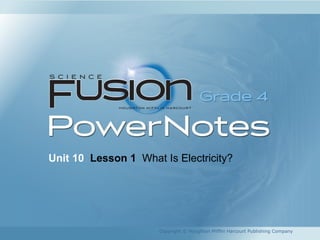More Related Content
Similar to Unit 10 lesson 1 what is electricity
Similar to Unit 10 lesson 1 what is electricity (20)
Unit 10 lesson 1 what is electricity
- 1. Unit 10 Lesson 1 What Is Electricity?
Copyright © Houghton Mifflin Harcourt Publishing Company
- 2. Unit 10 Lesson 1 What Is Electricity?
All Charged Up
• Atoms are the building blocks of matter.
• Atoms are so small you cannot see them with your
eyes alone. They are made of smaller particles
called protons, neutrons, and electrons.
• Electric charge is a property of a particle that
affects how it behaves around other particles.
Copyright © Houghton Mifflin Harcourt Publishing Company
- 3. Unit 10 Lesson 1 What Is Electricity?
All Charged Up
• Protons have a positive charge (+1).
• Electrons have a negative charge (–1).
• Neutrons are neutral. They have no charge.
Copyright © Houghton Mifflin Harcourt Publishing Company
- 4. Unit 10 Lesson 1 What Is Electricity?
All Charged Up
• When an atom has equal numbers of protons and
electrons, the charges cancel each other.
• Atoms sometimes gain or lose electrons. Gaining
or losing electrons will change the positive or
negative charges of the atom.
• If an atom gains electrons, it will have a negative
charge. If a neutral atom loses an electron, it will
have a positive charge.
Copyright © Houghton Mifflin Harcourt Publishing Company
- 5. Unit 10 Lesson 1 What Is Electricity?
Opposites Attract
• Particles with the same charge repel, or push
away from, one another.
• Particles with opposite charges attract one
another, or pull together.
• Static electricity is the buildup of electric
charges on objects.
• Static means “not moving.”
Copyright © Houghton Mifflin Harcourt Publishing Company
- 6. Unit 10 Lesson 1 What Is Electricity?
Opposites Attract
• Why does static electricity cause your hair to
stand “on end”?
Copyright © Houghton Mifflin Harcourt Publishing Company
- 7. Unit 10 Lesson 1 What Is Electricity?
Lightning Strikes
• Static charges stay on an object until it comes
close to an object with a different charge.
• An electrostatic discharge happens when electrons
jump from an object with a negative charge to an
object with a positive charge.
Copyright © Houghton Mifflin Harcourt Publishing Company
- 8. Unit 10 Lesson 1 What Is Electricity?
Lightning Strikes
• Raindrops and ice particles bump into each other
during a thunderstorm, causing an electric charge
to build in the clouds.
• Positive charges form at the top of a cloud and on
the ground. Negative charges form near the
bottom of the cloud.
• When the difference in charge between a cloud
and the ground is great enough, lightning occurs.
• Lightning is a huge electrostatic discharge.
Copyright © Houghton Mifflin Harcourt Publishing Company
- 9. Unit 10 Lesson 1 What Is Electricity?
Lightning Safety
• Stay inside and turn off electrical appliances.
• Stay away from windows.
• If you can’t get inside, wait in a car with a metal
roof.
• Listen to the weather forecast for updates about
thunderstorms.
• Make a plan in case a thunderstorm develops.
Copyright © Houghton Mifflin Harcourt Publishing Company
- 10. Unit 10 Lesson 1 What Is Electricity?
Current Events
• When electric charges have a path to follow, they
move in a steady flow called an electric current.
• Chemical reactions in batteries can provide a flow
of electrons.
• An electricity generating station is another source
of electric current.
Copyright © Houghton Mifflin Harcourt Publishing Company
- 11. Copyright © Houghton Mifflin Harcourt Publishing Company
Unit 10 Lesson 1 What Is Electricity?
Current Events
• What is the purpose of the insulator on the wire
shown below?
- 12. Unit 10 Lesson 1 What Is Electricity?
Current Events
• Moving electric charges are more useful than
static electricity.
• Electrons can be made to move through a wire.
They make up an electric current. You can use
electric current to do many kinds of work.
• Electric currents for homes, schools, and
businesses come from energy stations. These
stations change chemical, nuclear, or mechanical
energy into electrical energy.
Copyright © Houghton Mifflin Harcourt Publishing Company
